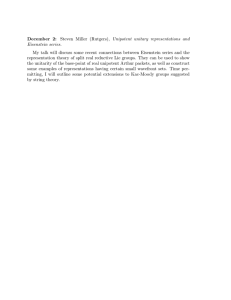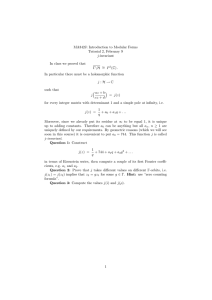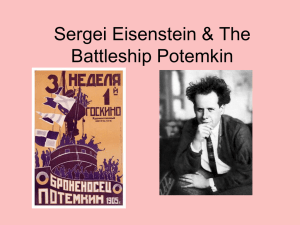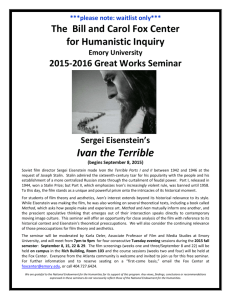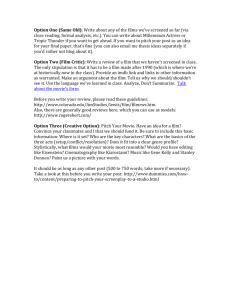IV. 4 March Eisenstein Key terms:
advertisement
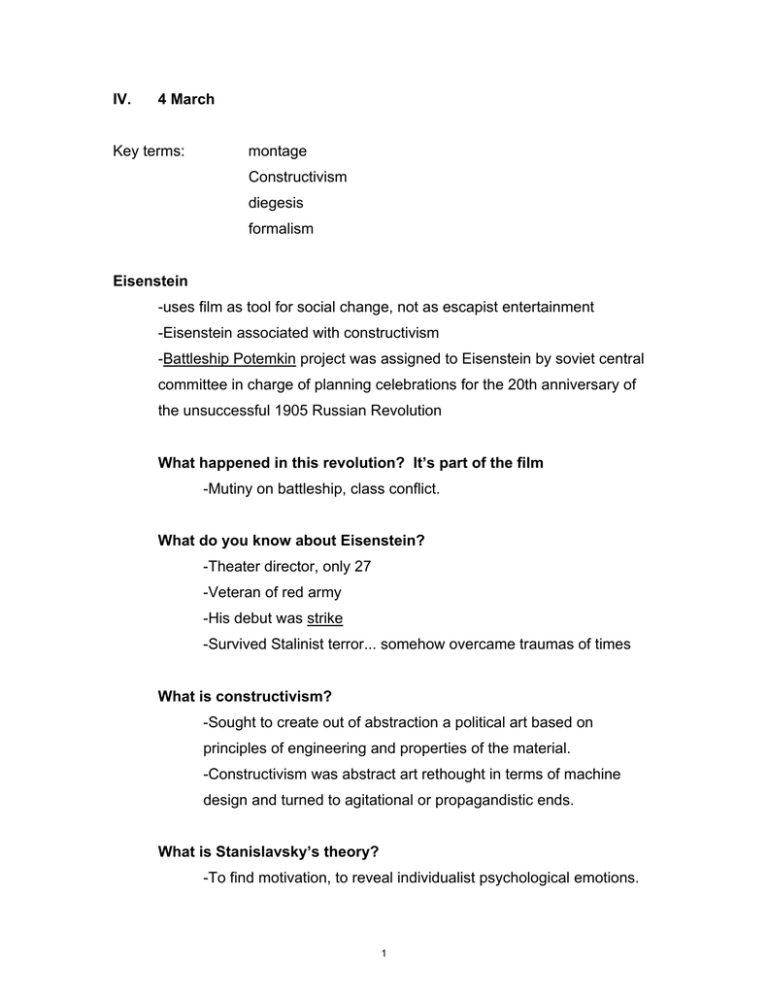
IV. 4 March Key terms: montage Constructivism diegesis formalism Eisenstein -uses film as tool for social change, not as escapist entertainment -Eisenstein associated with constructivism -Battleship Potemkin project was assigned to Eisenstein by soviet central committee in charge of planning celebrations for the 20th anniversary of the unsuccessful 1905 Russian Revolution What happened in this revolution? It’s part of the film -Mutiny on battleship, class conflict. What do you know about Eisenstein? -Theater director, only 27 -Veteran of red army -His debut was strike -Survived Stalinist terror... somehow overcame traumas of times What is constructivism? -Sought to create out of abstraction a political art based on principles of engineering and properties of the material. -Constructivism was abstract art rethought in terms of machine design and turned to agitational or propagandistic ends. What is Stanislavsky’s theory? -To find motivation, to reveal individualist psychological emotions. 1 How is Eisenstein different? -Borrows Meyerhold’s idea of biomechanical acting--just do the actions to tell the story/make the point -Eisenstein uses typage over and against academy actors “A 30 yr old actor may be called to play an old man of 60. He may have a few days or a few hours rehearsal. But an old man will have had 60 yrs rehearsal!” -Eisenstein more interested in class than individual How does this interest play out in Battleship? -No hero-- Vakulinchuk dies off early on -Anti-heroization marks Eisenstein’s divergence from narrative cinema -One idea important to constructivist filmmakers is that of the kinoeye. Eisenstein alters this and makes it into a kino-fist. What does kino-fist suggest about Eisenstein’s technique? -Collision -Conflict Montage-- to mount, 1929 -Production of a rapid succession of images in a motion picture to illustrate an association of ideas -Shots aren’t linked, but rather conflict with one another -Uses montage to establish dialectical film form -Antithetical concepts clash and produce a synthesis that supercedes/sublates individual elements How does montage function? Montage displays Eisenstein’s genius for editing 2 --Breaks individual actions down to multiple shots --Multiple angles stimulate viewer --Repeats some actions for emphasis (plate broken twice) --Rapid cutting, two second clips... effect of violence, action --Use visual space (screen) as site of conflict --Not about continuity of narrative --Social meaning is created by clashing concepts --Uses non-diegetic images (i.e. elements that exist outside the story world). Diegesis, 1953 The narrative presented by a cinematographic film or literary work; the fictional time, place, characters, and events which constitute the universe of the narrative. --Uses graphic contrasts from shot to shot What is the point? -To assume the viewer into the film viewer works to make -meaning of film -Viewer is producer and audience is united What is Eisenstein’s dialectic of film form? What is a dialectic? How is dialectic different for Hegel, Adorno, and Eisenstein? What is dialectical materialism? -Official philosophy of Communism -Dialectical materialism is meant to provide both a general worldview and a specific method for the investigation of scientific problems. -The basic tenets: 3 --Everything is material --Change takes place through “the struggle of opposites.” -So, everything contains different elements that are in opposition. -Because of this, “self-movement” automatically occurs...the conflict of opposing forces leads to growth, change, and development...and all this happens according to definite laws. What is historical materialism? -Class struggle that produces the dynamic of history and is the source of dialectical progress toward a final uniformity. -Historical materialism is deterministic; that is, it prescribes that history inevitably follows certain laws and that individuals have little or no influence on its development. Russian futurism -Sought an art that would break down distinctions between the world of art and that of everyday life. The word as such/ the material as such -Futurists wanted to make lit and art ‘difficult’ -Theorist Viktor Shklovsky (a Russian formalist, assoc. with futurists) proposed the idea of ‘defamiliarization.’--make things strange by foregrounding the devices of art, the audience could see, and become conscious of, the artifice; they would not be bewitched by its narrative content, nor lulled into the everyday complacency of accepting semantic reference (Mayakovsky does this). What is suprematism? -Movement founded (1913) by Kazimir Malevich in Moscow, parallel to constructivism. 4 -Malevich drew Alexander Rodchenko and El Lissitsky to his revolutionary, nonobjective art. In Malevich’s words, suprematism sought “to liberate art from the ballast of the representational world.” -It consisted of geometrical shapes flatly painted on the pure canvas surface. -Malevich’s white square on a white ground embodied the movement’s principles. -Suprematism, through its dissemination by the Bauhaus, deeply influenced the development of modern European art, architecture, and industrial design. Vasilii Kandinsky was part of this cultural moment. -1866–1944 -Usually regarded as the originator of abstract art. -He then developed his ideas concerning the power of pure color and nonrepresentational painting. His first work in this mode was completed in 1910, the year in which he wrote an important theoretical study, Concerning the Spiritual in Art. In this work he examines the psychological effects of color. After that he returned to Moscow, where he taught and directed artistic activities. During the early 1920s his style evolved from riotous bursts of color in his “Improvisations” to more precise, geometrically arranged compositions. In 1921 he returned to Germany and the next year joined the Bauhaus faculty. So was Vladimir Mayakovsky -1893–1930 -Poet, dramatist -Leader of the futurist school in 1912 5 -Chief poet of the revolution. 6 MIT OpenCourseWare http://ocw.mit.edu 21G.031J / 4.608J Topics in the Avant-Garde in Literature and Cinema Spring 2003 For information about citing these materials or our Terms of Use, visit: http://ocw.mit.edu/terms.

